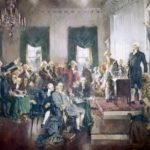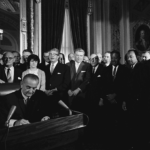In a constitutional system of government, the role of the judiciary is essential for maintaining the balance of power, protecting individual rights, upholding the rule of law, interpreting the Constitution, and ensuring equal justice for all. In this lesson, students learn about the role of an independent judiciary in the United States.
The Constitutional Convention: Composition of Congress
History is the chronicle of choices made by actors/agents/protagonists in specific contexts. This simulation places students at the Constitutional Convention and asks them to construct a legislative branch for a proposed new government. Should there be one branch or two? Should each state get an equal voice in the legislative branch? By discussing and debating the various options, they will gain a deeper understanding of the choices the framers faced and why they opted for particular structures, ones we live with today.
Article I: The Legislative Branch
The power to make laws in our country falls in the hands of the Legislative Branch. The branch is outlined in Article I of the Constitution. The Legislative Branch is divided into two houses of Congress. The House of Representatives is made up of representatives proportionate to their state’s population while each state maintains equal representation in the Senate. Learn all about Article I in the National Constitution Center’s learning module.
James Madison at the Constitutional Convention

This video focuses on James Madison’s efforts to shape deliberation at the Constitutional Convention. His major goal was to replace the system of voluntary compliance of the states under the Article of Confederation with a system of law to compel compliance under the federal Constitution. Professor Jack Rakove explains Madison’s perspective that without such a system, the different interests within each state, coupled with diverse interests among the states, precluded effective governance.
Making the Constitution (CKHG Unit)
Students who listen to this Grade 2 Core Knowledge History and Geography unit discover that Americans had a difficult task at hand after winning the Revolutionary War: they had to figure out a better way to govern themselves. Such leaders as James Madison, George Washington, Alexander Hamilton, and Benjamin Franklin traveled to Philadelphia to meet at the Constitutional Convention, with the goal of creating a new government. Students learn that the talks were held in secret in Independence Hall and that American leaders argued about many issues until they agreed to approve a new Constitution. They then hear that James Madison (whom we call the Father of the Constitution), along with John Jay and Alexander Hamilton, wrote the Federalist Papers to explain the document’s merits and to persuade the states to vote for it. Students find out that the states did finally approve the Constitution; that Madison wrote a Bill of Rights that was added to it; that the Constitution gives the American people the right to decide what the laws should be for our country; and that we can still amend it today.(5 lessons)
Article VII: Ratification
After months of debate during the hot Philadelphia summer, on September 17, 1787, the Constitutional Convention finally adjourned and the new Constitution was signed, but it was not the law of the land yet. According to Article VII of the document, nine of 13 states would have to ratify (or approve) the new Constitution before it would officially replace the Articles of Confederation as our governing document.
Voting Rights Act of 1965: Lesson Plans & Resources

On August 6, 1965, President Lyndon B. Johnson signed the Voting Rights Act into law. This landmark piece of legislation made discrimination based on race illegal. This law protected the right to vote for all citizens; forced states to obey the Constitution; and reinforced the 15th Amendment. The Share My Lesson team has curated a collection of free lesson plans, activities, and classroom materials that educators can use to teach students about the Voting Rights Act.
Moments in History: Remembering Thurgood Marshall
Few people know the legal mind of justices or judges as well as the law clerks who have worked with them. Justice Thurgood Marshall’s former law clerks offer unique insights into the character, values, and thought processes of the first African American to serve on the Supreme Court of the United States. In this 8.5-minute video called “Moments in History: Remembering Thurgood Marshall,” prominent lawyers reminisce about the examples of compassion and courage they saw in the life and work of this legal legend.
The Constitution in Action – State Challenges to Federal Authority: The Kentucky and Virginia Resolutions
Students in this simulation, as Republican members of the Kentucky and Virginia legislatures in 1798 and 1799, consider how they will oppose the Alien and Sedition Acts. Students will then act as members of other state legislatures and consider how to respond to Kentucky and Virginia. By engaging in this historical moment, students will wrestle with the ongoing tension between the Article VI, Clause 2, of the Constitution, which establishes the federal government as the “supreme Law of the Land,” and the Tenth Amendment, which reserves powers “not delegated to the United States” to the states or the people.
Choosing to Make a Nation: Constitutional Convention Simulation
The Choosing to Make a Nation Curriculum Project developed by award-winning author Ray Raphael is a student-centered, primary source-rich approach to teaching about American history and our nation‘s founding documents.
An 8-lesson simulation in which students become delegates from specific states and address the same issues the framers faced. Unit includes the following lesson plans –
(1) Reform or Revolution?
(2) Composition of Congress
(3) Creating an Executive Branch
(4) Should Judges Judge Laws?
(5) Balance of Powers
(6) Slavery and the Constitution
(7) Amendments and Ratification
(8) To Sign or Not to Sign?
Option A: The historical Constitution
Option B: Student-generated constitution